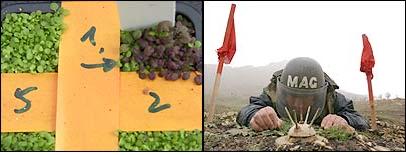A Danish company has changed the properties of a plant so that it changes color to red when it detects traces of an explosive substance in the soil. There are tens of millions of landmines around the world, the evacuation process of which takes a long time

About 26 thousand people are killed or injured every year, as a result of stepping on mines around the world. These are the "Red Cross" figures, which sound reasonable in view of estimates that 45-200 million landmines lie in about 60 countries in the world. Throughout Angola, for example, there are still 15-9 million mines, in Cambodia 8-10 million, in Egypt about 23 million and in Iraq about 10 million.
Various organizations invest a lot of time and resources in removing mines (the UN alone spends 200-300 million dollars a year to clear about 100 mines), but the process of locating, removing and destroying them takes a long time and they continue to pose a danger.
Now a Danish biotechnology company believes that it can shorten the process - using plants. "Aresa" succeeded in genetically engineering the properties of a plant, so that it changes its color from green to red when it is near explosives or mines. According to the company, sowing the plant in minefields may speed up the rate of mine detection and evacuation up to 10 times and reduce the process by a third.
Today there are various methods for neutralizing mines, with the traditional way being to locate and remove the mine manually, and then detonate it. The main problem is that the edges of the mines do not have accurate information about their location, so they have to scan the entire area until they are sure that the area is free of mines - and a population can settle there. However, sometimes the areas suspected of being hacked extend over hundreds and thousands of kilometers, and scanning them takes a long time.
Aresa believes that it can reduce the time required to locate mines, using a genetically modified version of the plant Thale Cress (scientific name "Arabidopsis Thaliana"). Social scientists took advantage of the fact that the plant has a red pigment, which is usually visible in autumn, and changed its properties. When the transgenic plant detects traces of heavy metals or nitrogen dioxide in the soil - a chemical found in explosives such as C4 or TNT - an enzyme is activated that leads to the creation of the pigment, which vaporizes the color of the leaves.
Seeding from the air or around the suspected areas
Barça, which has already started conducting experiments with the plant, claim that sowing the plant has several important advantages. For example, the plant is environmentally friendly and does not spread to other areas. Also, its growth cycle is fast (six-eight weeks), so it will allow identifying the location of the mines in a short time. The company emphasizes that the method will not replace other methods for locating mines, but in some cases it may save time and resources.
In an interview with the "Scotsman" newspaper, Carsten Meier, the company's chief scientist, said: "The main benefit that the plant brings is that you stop wasting your time on sites where there are no mines at all." According to him, the average rate of clearing mines is two square meters per person per day. "It takes six months to clear an area the size of a football field - a tiny area in places like Angola or Sierra Leone."
The development of the plant is in its final stages, and the company intends to start field trials this year, probably in Bosnia and Sri Lanka. The company spokesmen told the news agencies that they hope that within two years it will be possible to start making extensive use of their invention.
The plant makes it possible to identify where mines are located, but for this purpose it must be sown in areas suspected of being mined. How does the company intend to solve the problem? One way is to scatter the plant's seeds from an airplane. A second way is to clear certain areas in traditional ways, and then sow the plant around them.
